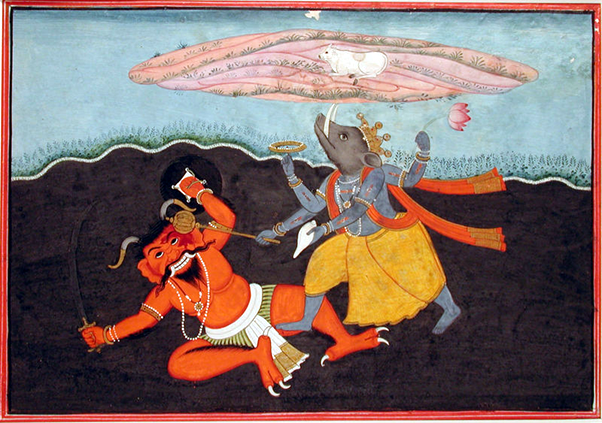
Lord Varaha lifting a flat earth
What Happened to Mother Earth, Part 2
BY: MAYESVARA DASA
Mar 01, 2021 — IRELAND (SUN) — Part One of this paper can be found here.
Although the next two paintings are missing some of the aforesaid features (the goddess, the cow, and the temple) they are interesting nonetheless for the simple reason that they do not depict the Earth as a globe. Again if the creators of these sacred images had believed the Earth was globe-shaped they would have certainly depicted it as such.
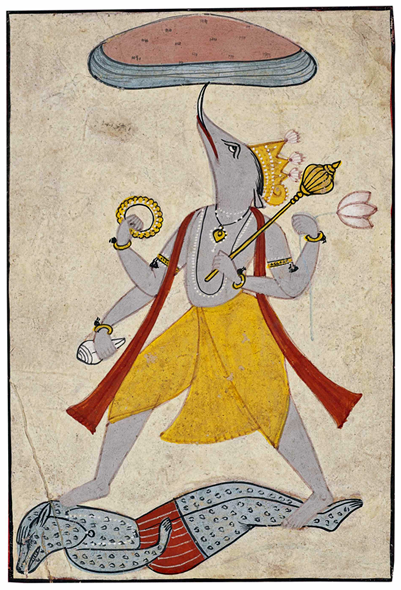 Varaha, Himachal Pradesh 1720
Varaha, Himachal Pradesh 1720Christies Auctions, 2016
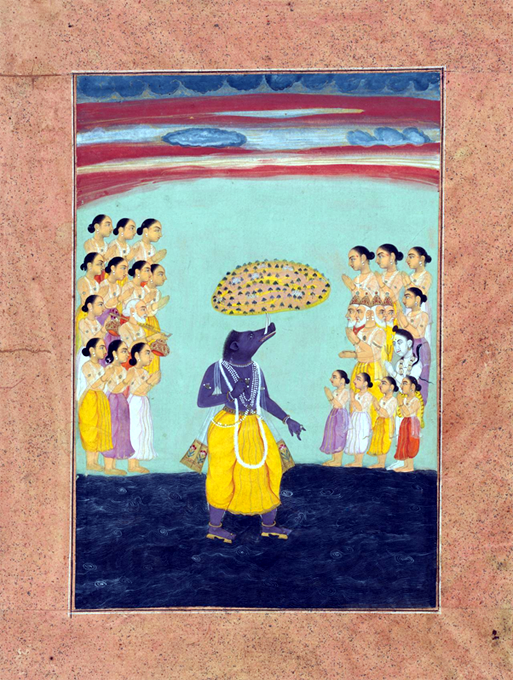 Varaha, Rajasthan, India (1725)
Varaha, Rajasthan, India (1725)National Gallery of Victoria, Melbourne
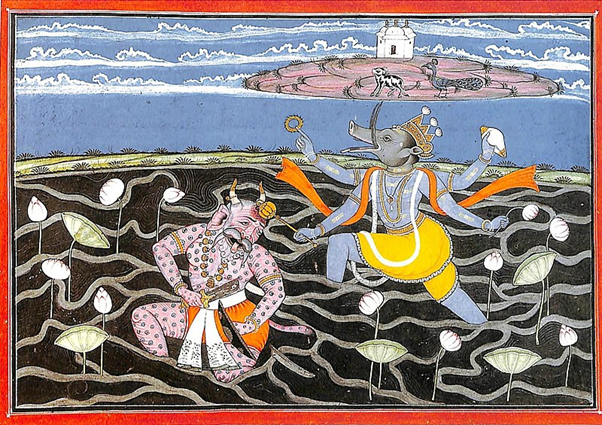 Varaha the Boar Incarnation of Vishnu, c. 1725-50
Varaha the Boar Incarnation of Vishnu, c. 1725-50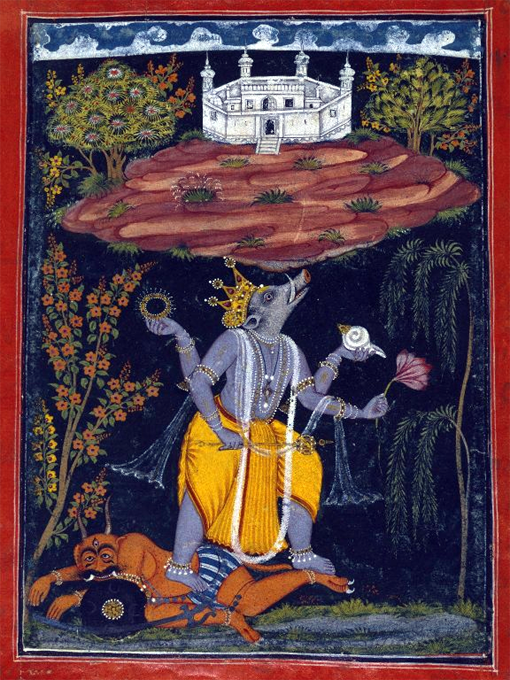 Varaha Rescuing the Earth, c. 1720-50
Varaha Rescuing the Earth, c. 1720-50Brooklyn Museum.
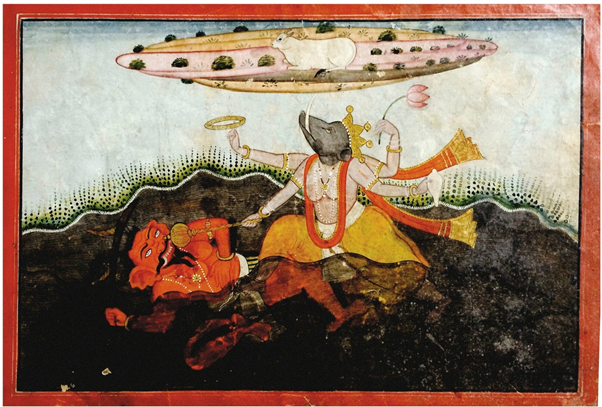 Varaha, Pahari, Chamba, c. 1730-40
Varaha, Pahari, Chamba, c. 1730-40Cleveland Museum of Art
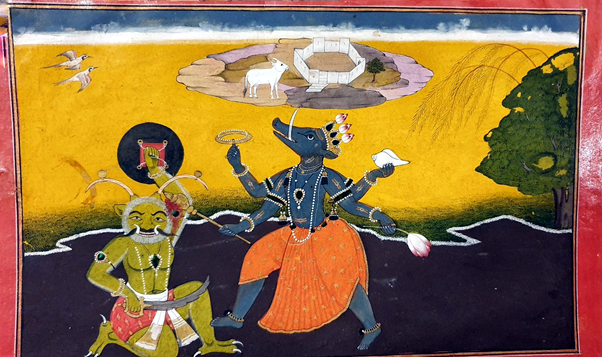 Varaha Killing Hiranyaksha and Saving the World, Basohli, c. 1730
Varaha Killing Hiranyaksha and Saving the World, Basohli, c. 1730Lahore Museum
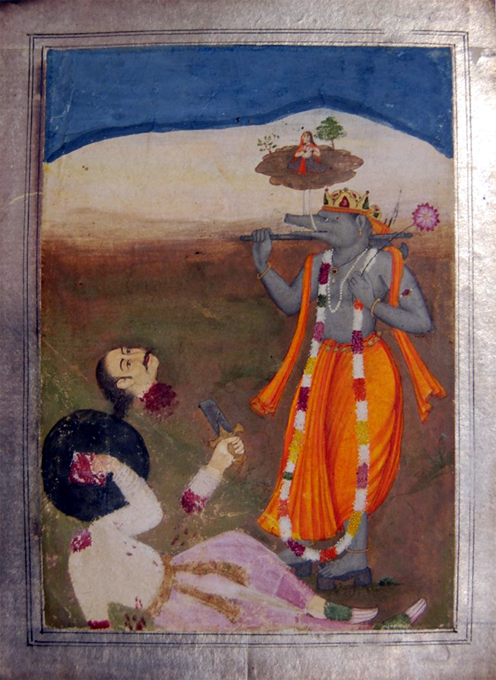 Varaha, the Third Incarnation of Viṣṇu, Stands in Front of the
Varaha, the Third Incarnation of Viṣṇu, Stands in Front of theDecapitated Body of the Demon Hiranyaksha, c. 1751-1850
British Museum Collection
 Varaha Kills the Demon Hiranyaksha, c. 1760
Varaha Kills the Demon Hiranyaksha, c. 1760San Diego Museum of Art
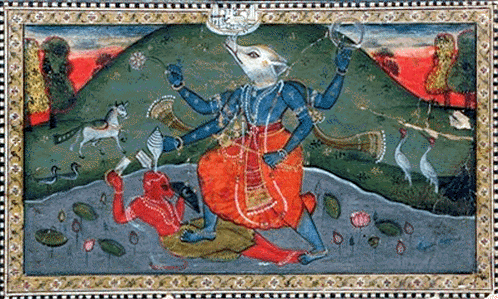 Varaha Avatar (Folio from a Dasavatara series) Kotah, 1760
Varaha Avatar (Folio from a Dasavatara series) Kotah, 1760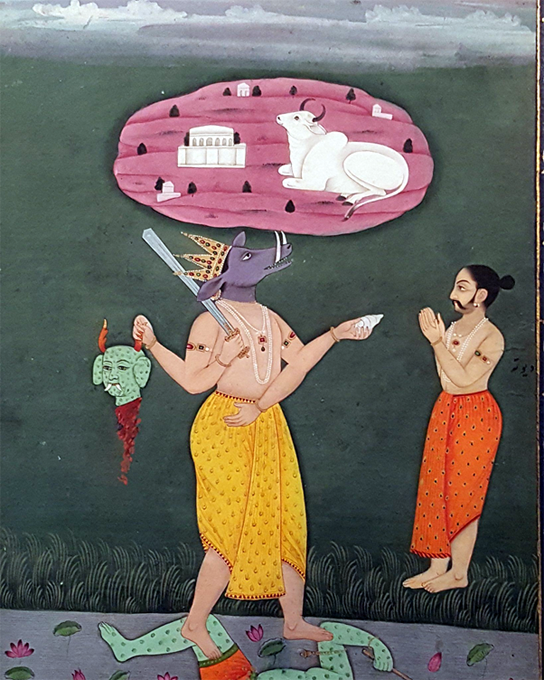 Varaha Rescues the World from the Waters, Bengal, c. 1775
Varaha Rescues the World from the Waters, Bengal, c. 1775Chester Beatty Museum, Dublin
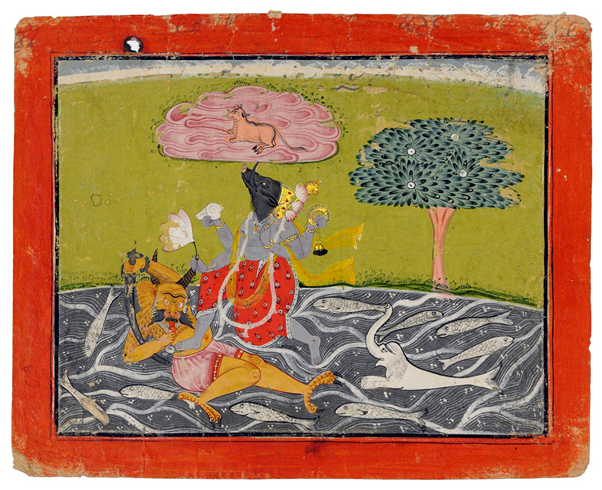 Varaha, an Illustration to a Dasavatara Series, Chamba School, Punjab, c. 1700
Varaha, an Illustration to a Dasavatara Series, Chamba School, Punjab, c. 1700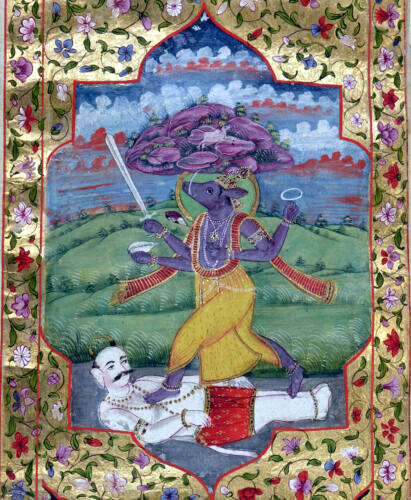 Varaha Lifting the Earth, from an Illustrated Bhagavata Purana, c. 1800
Varaha Lifting the Earth, from an Illustrated Bhagavata Purana, c. 1800Bibliotheque Nationale de France
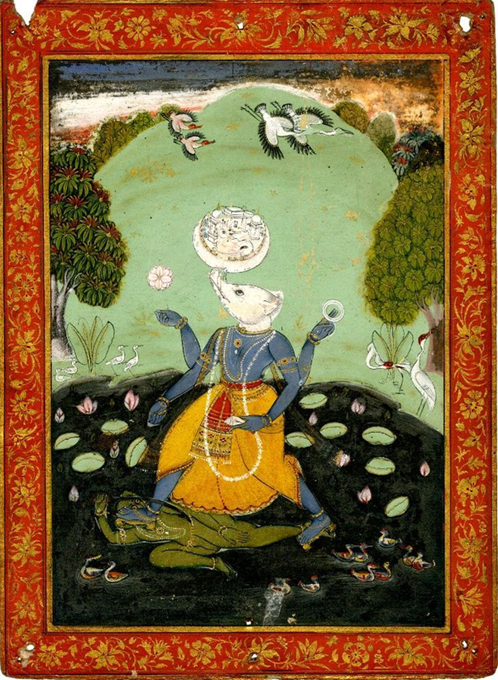 Varaha, the Boar Incarnation of Vishnu, Rajastan School (1790-1810)
Varaha, the Boar Incarnation of Vishnu, Rajastan School (1790-1810)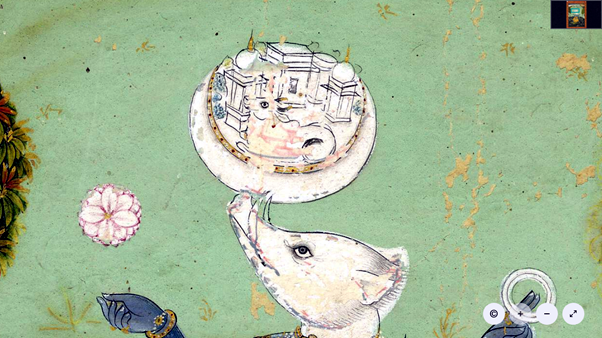 Varaha, the Boar Avatar of Visnu
Varaha, the Boar Avatar of VisnuBritish Museum
THE OCEAN BELOW THE EARTH
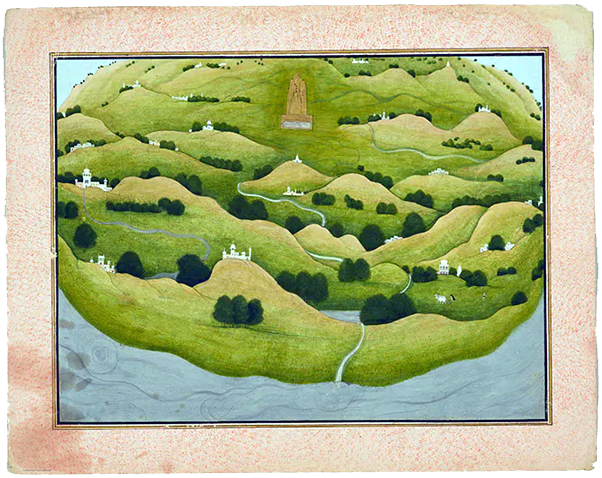 Earth having been lifted from the flood water
Earth having been lifted from the flood waterBhagavata Purana series, c. 1775–90, Nainsukh family workshop, Parahi
Royal Collection Trust
This painting is interesting because it not only shows the Earth in circular form, but it shows the Earth situated above the water of the Garbhodaka Ocean, (not surrounded by dark space, as should be the case if the people at the time actually thought that was how the Earth was situated). The Puranas do not describe the Earth as being situated in an infinite dark space with all manner of planets and stars both above and below (as modern images of the Earth portray). In Vedic cosmology all the stars and planets are above the Earth. The only thing below the Earth is Ananta-sesha who resides on the Garbhodaka Ocean. This is explained in the Caitanya-caritamrita by Srila Krishna dasa Kaviraja Goswami as follows:
“After creating millions of universes, the first purusha entered into each of them in a separate form, as Sri Garbhodakasayi. Entering the universe, He found only darkness, with no place in which to reside. Thus He began to consider. Then He created water from the perspiration of His own body and with that water filled half the universe. The universe measures five hundred million yojanas. Its length and breadth are one and the same. After filling half the universe with water, He made His own residence therein and manifested the fourteen worlds in the other half. There He manifested Vaikuntha as His own abode and rested in the waters on the bed of Lord Sesha. He lay there with Ananta as His bed. Lord Ananta is a divine serpent having thousands of heads, thousands of faces, thousands of eyes and thousands of hands and feet. He is the seed of all incarnations and is the cause of the material world.” (Caitanya-caritamrita, Adi-lila, 5.94-101)
Here it says, sei jale kaila ardha-brahmanda bharana—Vishnu filled half (ardha) the universe (Brahmanda) with water (jale). In his commentary to SB 5.23.9, Srila Visvanatha Chakravarti Thakura states that the universe is 500,000,000 million yojanas from top to bottom, and that the Garbhodaka Ocean is just slightly less than half of that measure having a depth of 249,800,000 yojanas deep. Krishna dasa Kaviraja Goswami goes on to say that Sesha holds the Earth (Dharani) on His head: sei vishnu ‘sesha’-rupe dharena dharani (CC Adi. 5.117). The Earth in question (Prthivi) is thereafter described as being 500 million yojanas in diameter (pancasat koti yojana) and resting like a mustard seed on the head of Ananta-sesha (CC Adi. 5.119). The picture below shows Kurma and Sesha on the water of Garbhodaka Ocean with the Earth on the hoods of Ananta.
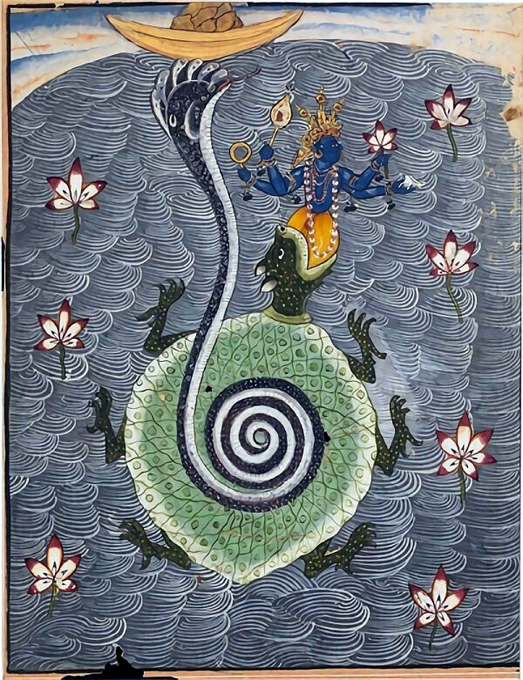 Kurma supporting Ananta-sesha who holds Earth on his hoods, c.1690
Kurma supporting Ananta-sesha who holds Earth on his hoods, c.1690Asian Art Museum
“At whose command the water carries the tortoise, the tortoise carries the serpent Sesa, and the serpent Ananta carries the Earth while the Earth carries all the oceans, seven continents, the seven mountains and all the people in all the forms.” (Brahma-vivarta Purana, Prakrti Khanda, chapter 34)
A TRICK OF MAYA
The next painting shows a flat-Earth held on the horns of a cow.
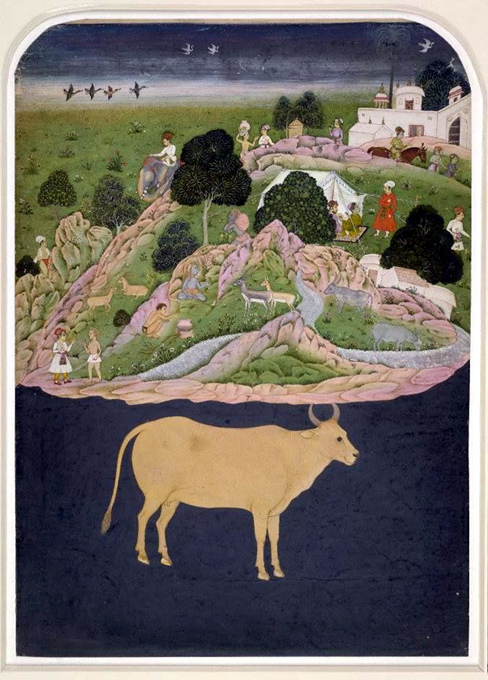 A Cow Supporting the Weight of the Earth on its Horns
A Cow Supporting the Weight of the Earth on its HornsBikaner, Rajasthan School, c. 1700-1720
British Museum
The idea is most likely a variation on the Vedic teaching that the Earth is supported by Ananta-sesha and Kurma. What is interesting about the above painting is that the Earth is again depicted as a flat landscape. We shall discuss in a later paper how the introduction of the globe into India by the Jesuits was immediately welcomed by the Muslim rulers of the time. The Sultans found the globe to be a unique symbol that could effectively demonstrate their power over all that be. By standing on the globe, one seemingly stood as emperor over the entire Earth. In the picture we see a Muslim ruler standing on the Earth which is held by the Bull and fish, but in this case the flat-Earth (shown in the above picture) has been depicted instead as a globe.
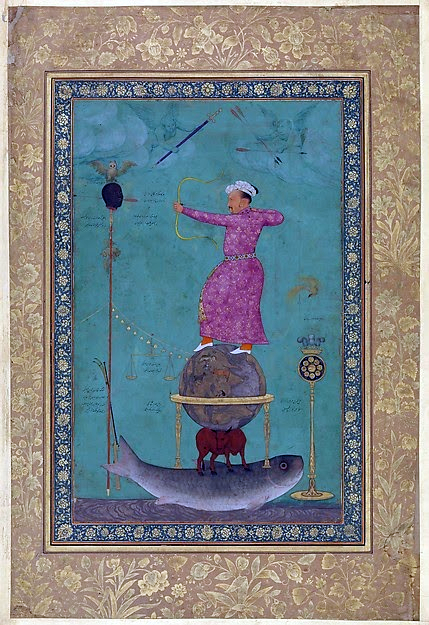
“My dear King Pariksit, all these kings I have described, as well as all other human beings, come to this Earth and stake their claims, but ultimately they all must give up this world and meet their destruction. Even though a person’s body may now have the designation “king,” in the end its name will be “worms,” “stool” or “ashes.” What can a person who injures other living beings for the sake of his body know about his own self-interest, since his activities are simply leading him to hell? [The materialistic king thinks:] “This unbounded earth was held by my predecessors and is now under my sovereignty. How can I arrange for it to remain in the hands of my sons, grandsons and other descendants?” Although the foolish accept the body made of earth, water and fire as “me” and this earth as “mine,” in every case they have ultimately abandoned both their body and the earth and passed away into oblivion. My dear King Pariksit, all these kings who tried to enjoy the earth by their strength were reduced by the force of time to nothing more than historical accounts.” (SB 12.2.40-44)
The next painting from 1790 shows a very flat Earth with many transcendental temples on its surface.
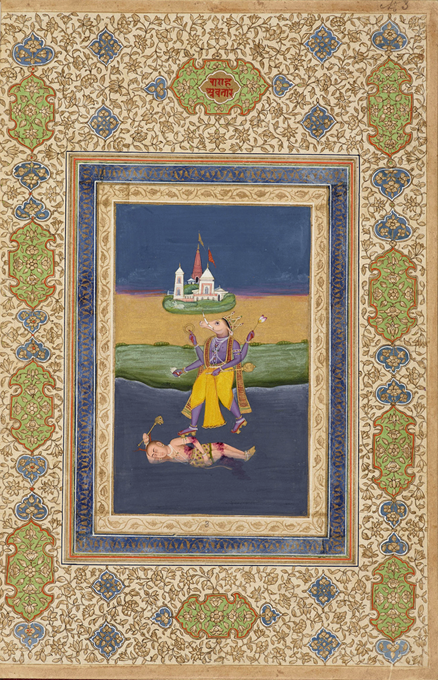 Varaha, the third incarnation of Vishnu, c. 1790
Varaha, the third incarnation of Vishnu, c. 1790Albert Royal Collection Trust
Though the depiction of the flat-Earth in the above paintings may appear somewhat simplistic and naive, it must be borne in mind that the depictions of the Earth as a flat-Earth landscape were never intended to present accurate and sophisticated models of the Earth-circle as it scientifically described in the Vedic Puranas. The shape and size of the Earth-circle along with descriptions of the various lokas in the universe, was elsewhere taught in gurukulas, temples, and ashramas with the help of various complex diagrams depicting the virat-rupa (universal form). The images below from the Vedic Cosmos documentary show a sannyasin teaching Vedic cosmology whilst pointing to a traditional map of Bhu-mandala and the greater cosmos.
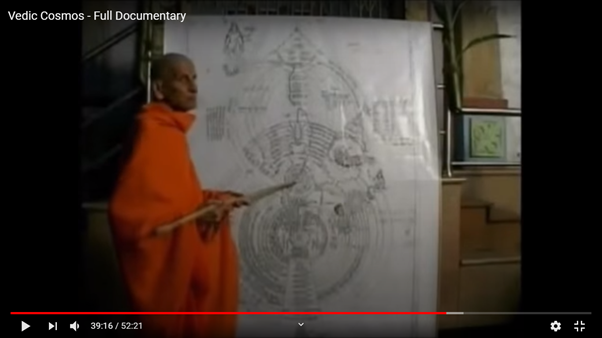
We have so far looked at many examples of paintings from the 17th and 18th century all of which depict the Earth as a flat-Earth along with the personified Earth goddess who appears on the landscape either as a female or in the form of a cow. In part two of this paper we shall show some further examples of flat-Earth paintings from the 19th century; we shall then show how the whole scene dramatically changed in the 20th century with the beginning of paintings depicting Varaha holding a globe-shaped Earth.







Letter to: Jadurani
—
Los Angeles
15 February, 1968
68-02-15
Yes, Varaha is very beautiful. Generally, the Boar picture is depicted as half human, and half boar, but in Bhagavatam it is stated that full boar. You can make the first 2 legs as 2 hands, and the rear legs and legs, and make it as beautiful as possible.
Hare Krishna
SB 2.7.1, Purport: Lord Brahmā is the first demigod, and Hiraṇyākṣa is the first demon in this universe. Only under certain conditions do the planets float as weightless balls in the air, and as soon as these conditions are disturbed, the planets may fall down in the Garbhodaka Ocean, which covers half the universe. The other half is the spherical dome within which the innumerable planetary systems exist. The floating of the planets in the weightless air is due to the inner constitution of the globes, and the modernized drilling of the earth to exploit oil from within is a sort of disturbance by the modern demons and can result in a greatly harmful reaction to the floating condition of the earth. A similar disturbance was created formerly by the demons headed by Hiraṇyākṣa (the great exploiter of the gold rush), and the earth was detached from its weightless condition and fell down into the Garbhodaka Ocean.
Lecture on BG 1.43 — London, July 30, 1973:
So Brahmā means the manager of one brahmāṇḍa, universe. And there are millions of Brahmās, millions, trillions. They are numberless. Ananta-koṭi. Yasya prabhā prabhavato jagad-aṇḍa-koṭiḥ (Bs. 5.40). Koṭi. Koṭi means unlimited. Jagad-aṇḍa. Jagad-aṇḍa means universe. Brahmāṇḍa or jagad-aṇḍa. Aṇḍa. Aṇḍa means it is egg-shaped, round, egg-shaped. Therefore it is called aṇḍa, brahmāṇḍa. Bhū-gola. Gola means round. I have heard that before the science, the people were under the impression that this world is square. Is it not?
Devotees: Flat.
Prabhupāda: Flat. Flat, yes. But in the Vedic śāstra, millions of years ago it is mentioned: bhū-gola. Gola means round. Just see. And these rascals say that formerly people were not so intelligent. They are intelligent because they are thinking that this world is flat. And those who have spoken millions of years ago, “It is round,” they will have less intelligence. Just see. Bhū, gola. Gola means round. Bhū-gola. Similarly, jagad-aṇḍa. Anda means round, just like egg. Aṇḍa means egg. Jagad-aṇḍa. This universe is egg-shaped. And we can see also, the sky is round. This is the wall of this universe.”
In Srimad Bhagavatam 5.21.8-9;
“People living in countries at points diametrically opposite to where the sun is first seen rising will see the sun setting, and if a straight line were drawn from a point where the sun is at midday, the people in countries at the opposite end of the line would be experiencing midnight. Similarly, if people residing where the sun is setting were to go to countries diametrically opposite, they would not see the sun in the same condition.”
SB 3.2.7, Translation and Purport.
“The comparison of Kṛṣṇa to the sun is very appropriate. As soon as the sun sets, darkness automatically appears. But the darkness experienced by the common man does not affect the sun itself either at the time of sunrise or of sunset. Lord Kṛṣṇa’s appearance and disappearance are exactly like that of the sun. He appears and disappears in innumerable universes, and as long as He is present in a particular universe there is all transcendental light in that universe, but the universe from which He passes away is put into darkness. His pastimes, however, are everlasting. The Lord is always present in some universe, just as the sun is present in either the eastern or the western hemisphere. The sun is always present either in India or in America, but when the sun is present in India, the American land is in darkness, and when the sun is present in America, the Indian hemisphere is in darkness.”
Los Angeles 20th December 1968. Letter to Hayagriva dasa.
Regarding your question of the planetary systems, the planets are arranged in each universe in layers like the petals of a lotus. But in each layer there is mixed both heavenly, hellish and middle planets. On the outside layer there are these three kinds of planets, on the middle layers there are the three kinds of planets and on the inner-most layer there are found these three kinds of planets. Above these layers, in the center, is the Brahmaloka where Lord Brahma, the creator is residing. So the earth planet and the moon planet are both on the same layer but the earth is middle planet and the moon is heavenly planet.
Letter to Hayagriva — Los Angeles 9 March, 1970: Regarding your question do the Vedic histories refer to this planet only. No. Vedic history means of this universe. Our history begins from the beginning of the creation because the creation takes place with the birth of Brahma from the abdomen lotus flower of Lord Visnu. Then Brahma gradually creates. He begets so many sons known as Prajapatis who are supposed to be the generators of living entities, and therefore the history begins from Brahma. In the Bhagavad-gita this is confirmed in the 15th chapter. It is said there that the root of this big universal banyan tree is on the top; therefore history begins from the top.
Yes. This planet comes later on. We can take the idea from the tree—the tree grows gradually, and the different fruits, branches, and twigs gradually appear. Therefore it is to be understood that this planet has grown later on. Besides this we understand that although the planet was later on grown up, it was covered with water—pralaya payodhi jale, merged into the water after devastation. Then gradually it emerges from water. That we can experience, that gradually land is coming out of the oceans. Because of its being merged into water, it is natural to conclude that the beginning of life was aquatic. This is confirmed in Padma Purāṇa that the species of life evolved from aquatics to plants, vegetables, trees; thereafter insects, reptiles, flies, birds, then beasts, and then human kind. This is the gradual process of evolution of species of life.
(BG 16.8)
This is the atheistic theory, asatyam. They say that this material world is false. Brahma satyaṁ jagan mithyā. Jagat, jagat means this cosmic manifestation which is gacchati, going. In the material world, everything is going. Just like in your city you see the cars, motor cars. They are going here and there, gacchati, very busy. Every man is going here and there. Similarly, the whole planetary system also, beginning from its birth up to the annihilation it is going, moving, orbit. It is going. Everything is going, moving. Even the sun, it has got its orbit. Yac-cakṣur eṣa savitā sakala-grahāṇāṁ rājā samasta…, aśeṣa-tejāḥ, yasyājñayā bhramati sambhṛta-kāla-cakraḥ. The… Just like the earth has its orbit—it is rotating—similarly, every planet is rotating. The sun is also rotating. And so far I calculate, it is sixteen thousand miles per minute or second. I calculated once. The sun is rotating sixteen thousand miles either per minute or per second. I forget now.
So this is called jagat. Everything is going on. But it is going in such a way… Just like these cars are moving with high speed, but they are very careful to pass within the lane. Otherwise there will be collision. Similarly, all these planets, they have got their own speed for rotating, and there are hundreds and thousands and millions. They are rotating, but there is no collision. Now, how it is made? Who has made this lane? A car is moving in sixty miles, seventy miles speed, but they are ordered just to remain within the lane, the marking line. Who has made it? The police department, the government. So how can you say there is no control? We have to… This is called upamā, analogy, the points of similarity. Analogy means the points of similarity. Then you can conclude some idea.
Now, as we see in the street that the cars are moving in high speed but they are within the orbit, within the line, demarcation of line, white line or yellow line, so there is some brain, there is some management, everything is there, Similarly, all these planets, they are rotating with high speed. Just like this planet. It is rotating 25,000 miles in twenty four hours. Is it not? The circumference of this earth is 25,000 miles and… Yes, day and night, twenty-four hours. Almost one thousand miles per hour it is… Now the car is moving seventy miles per hours. It appears very with good speed running. But the earth is running at one thousand miles per hour, but we cannot understand. The arrangement is so nice. The perfection that it is… We cannot understand it. It is practical. We see the morning, day, coming. That means earth is moving. When the aeroplane moves also, there are so many jerking, those sound. They’re all imperfect. But here you see that such perfect arrangement, it is moving one thousand miles per hour, and there is no jerking. There is nothing of the sort. We are thinking, “We are sitting in the same place.” And there is no brain? Here it requires so much brain to move the car orderly on the street. So many police has made, so many government, scientist, this, that, so many, and this not only one planet, but many millions: yasya prabhā prabhavato jagad-aṇḍa-koṭi (Bs. 5.40).
Lecture on SB 2.9.4-8 — Tokyo, April 23, 1972:
Prabhupāda: Just like when the first sputnik traveled round the world. In one hour, twenty-five minutes, this whole world was circum(am)bulated. So actually it takes so many hours if you circumambulate the whole world, 25,000 miles. Even by plane it will take day and night. What is the speed of aeroplane?
devotee: Five hundred miles an hour.
Prabhupāda: So one thousand miles, two hours. So 25,000 miles it will take fifty hours. But by other arrangement, it was circum(am)bulated one hour, twenty-five minutes. So, similarly, by other arrangement it can be done in one minute, in one second. It is a question of arranging.planet. It is rotating 25,000 miles in twenty four hours. Is it not? The circumference of this earth is 25,000 miles and… Yes, day and night, twenty-four hours. Almost one thousand miles per hour it is… Now the car is moving seventy miles per hours. It appears very with good speed running. But the earth is running at one thousand miles per hour, but we cannot understand. The arrangement is so nice. The perfection that it is… We cannot understand it. It is practical. We see the morning, day, coming. That means earth is moving.
SB 5.4.9, Translation and Purport:
Of Ṛṣabhadeva’s one hundred sons, the eldest, named Bharata, was a great, exalted devotee qualified with the best attributes. In his honor, this planet has become known as Bhārata-varṣa.
This planet known as Bhārata-varṣa is also called puṇya-bhūmi, the pious land. At the present moment Bhārata-bhūmi, or Bhārata-varṣa, is a small piece of land extending from the Himalaya Mountains to Cape Comorin. Sometimes this peninsula is called puṇya-bhūmi. Śrī Caitanya Mahāprabhu has given special importance to the people of this land.
SB 3.2.7, Translation and Purport.
“The comparison of Kṛṣṇa to the sun is very appropriate. As soon as the sun sets, darkness automatically appears. But the darkness experienced by the common man does not affect the sun itself either at the time of sunrise or of sunset. Lord Kṛṣṇa’s appearance and disappearance are exactly like that of the sun. He appears and disappears in innumerable universes, and as long as He is present in a particular universe there is all transcendental light in that universe, but the universe from which He passes away is put into darkness. His pastimes, however, are everlasting. The Lord is always present in some universe, just as the sun is present in either the eastern or the western hemisphere. The sun is always present either in India or in America, but when the sun is present in India, the American land is in darkness, and when the sun is present in America, the Indian hemisphere is in darkness.”
SB 3.18.19, Purport: Here the earth planet is called ilā. This earth was formerly known as Ilāvṛta-varṣa, and when Mahārāja Parīkṣit ruled the earth it was called Bhārata-varṣa. Actually, Bhārata-varṣa is the name for the entire planet, but gradually Bhārata-varṣa has come to mean India. As India has recently been divided into Pakistan and Hindustan, similarly the earth was formerly called Ilāvṛta-varṣa, but gradually as time passed it was divided by national boundaries.
SB 3.23.43, Purport: All the planets are here described as gola, round. Every planet is round, and each planet is a different shelter, just like islands in the great ocean. Planets are sometimes called dvīpa or varṣa. This earth planet is called Bhārata-varṣa because it was ruled by King Bharata.
Discussion on Darwin
Prabhupāda: At least he has no power to see everything. That is a fact. He’s not so powerful that he can see everywhere and everything. That you have to accept. He has limited power to see. By that limited power to see he cannot conclude that one species (is) extinct. That is not possible. No scientist will accept that. After all, your senses by which you are (indistinct), they’re limited. So how you can say, “This is finished,” or “This is that.” That is not to be accepted. Because your senses are imperfect. You cannot see. You cannot search out. Have you searched out all the earthly layers or the 25,000 miles everywhere? That is not possible for you. The whole earthly planet is circumference is 25,000 miles, radius how many, has he discovered that all the places?
Sri Isopanisad 10, Translation and Purport
Nationalism has developed in different parts of the world due to the cultivation of nescience by the general people. No one considers that this tiny earth is just a lump of matter floating in immeasurable space along with many other lumps. In comparison to the vastness of space, these material lumps are like dust particles in the air. Because God has kindly made these lumps of matter complete in themselves, they are perfectly equipped with all necessities for floating in space. The drivers of our spaceships may be very proud of their achievements, but they do not consider the supreme driver of these greater, more gigantic spaceships called planets.
SB 5.23.3, Translation and Purport
The question of how the planets and stars are floating is also answered in this verse. It is not because of the laws of gravity. Rather, the planets and stars are enabled to float by manipulations of the air. It is due to such manipulations that big, heavy clouds float and big eagles fly in the sky. Modern airplanes like the 747 jet aircraft work in a similar way: by controlling the air, they float high in the sky, resisting the tendency to fall to earth.
SB 3.29.42, Translation and Purport: Out of fear of the Supreme Personality of Godhead the rivers flow, and the ocean never overflows. Out of fear of Him only does fire burn and does the earth, with its mountains, not sink in the water of the universe.
It is said here that the planets do not sink. Since they are floating under the order or energy of the Supreme Godhead, they do not fall down into the water which covers half the universe. All the planets are heavy, with their various mountains, seas, oceans, cities, palaces and buildings, and yet they are floating. It is
understood from this passage that all the other planets that are floating in the air have oceans and mountains similar to those on this planet.
Letter to Madhava — Vrindaban 3 October, 1976: Please accept my blessings. I am in due receipt of your letter dated 22nd Sept. 1976 and have noted the contents. Regarding details of the universe, be satisfied by reading only Bhagavatam. What is the use of reading other books—you are not going there. Some portion of the earth is flat. When you stand in any place you see flat, so for us to some extent it appears flat, but it is round (not flat).
SB 3.21.2, Translation and Purport
The two great sons of Svāyambhuva Manu—Priyavrata and Uttānapāda—ruled the world, consisting of seven islands, just according to religious principles.
Śrīmad-Bhāgavatam is also a history of the great rulers of different parts of the universe. In this verse the names of Priyavrata and Uttānapāda, sons of Svāyambhuva, are mentioned. They ruled this earth, which is divided into seven islands. These seven islands are still current, as Asia, Europe, Africa, America, Australia and the North and South Poles. There is no chronological history of all the Indian kings in Śrīmad-Bhāgavatam, but the deeds of the most important kings, such as Priyavrata and Uttānapāda, and many others, like Lord Rāmacandra and Mahārāja Yudhiṣṭhira, are recorded because the activities of such pious kings are worth hearing; people may benefit by studying their histories.
Morning Walk — December 9, 1973, Los Angeles:
Yes, world is round. That is fact. Goloka (is round). In Vedic literature it is bhū-gola, jagad-aṇḍa. These words are there. We can see also it is round, jagad-aṇḍa. The universe is round. And Goloka. Or Bhū-gola. Bhū-gola, the earth is round. So in the Vedic literatures… Therefore their knowledge is also imperfect because they do not refer to the Vedic literatures. It is already there. Bhū-gola. Bhū means the earth; gola means round. It is already there. And the geography’s called, according to Sanskrit, it is called Bhū-gola.
Letter to Svarupa Damodara — Auckland 27 April, 1976: We can see that at night, how the whole planetary system is turning around, the pole star being the pivot. Each planet has its orbit fixed but the sun is moving up and down, north and south. It is not that we shall accept the theory that the sun is fixed up and the others are all going around the sun. That is not correct. Even the 7th star is rotating once around the pole star in each 24 hours. The whole universe is just like a big tree, that is a fact. I do not think that the modern astronomers have any such idea that the whole universe is like a big tree. The planets which are full of living entities are one after another, one above the other. The relative positions of the planets is fixed up but the whole thing is turning. The sun is going north and south, it has its own orbit below the moon. So now you all Ph.D.’s must carefully study the details of the 5th Canto and make a working model of the universe.